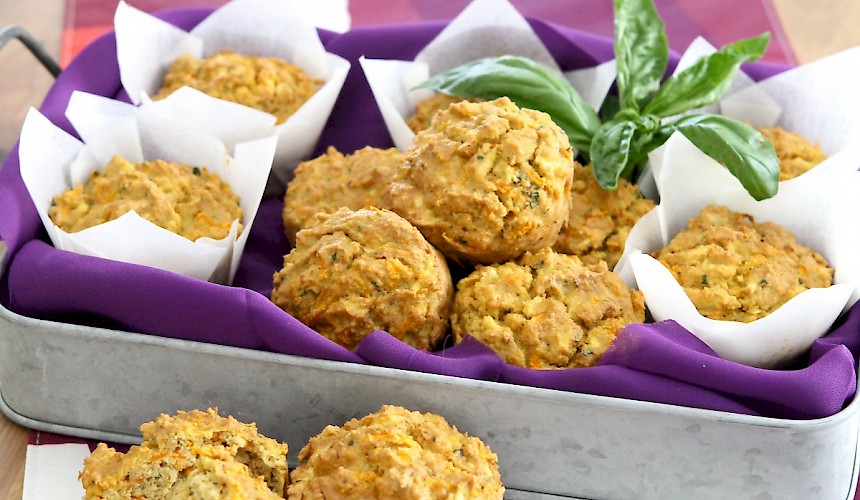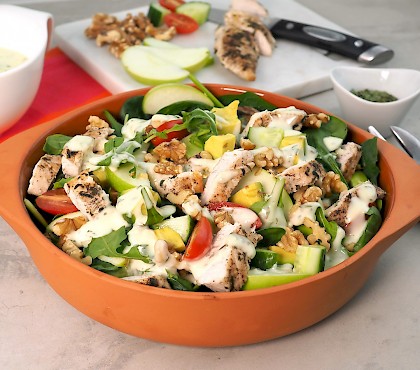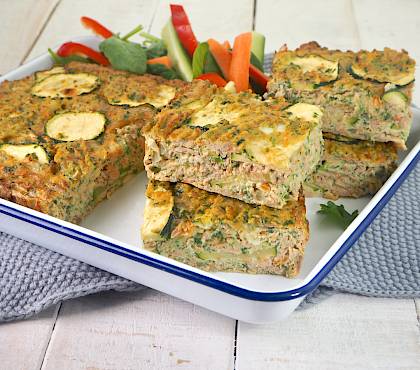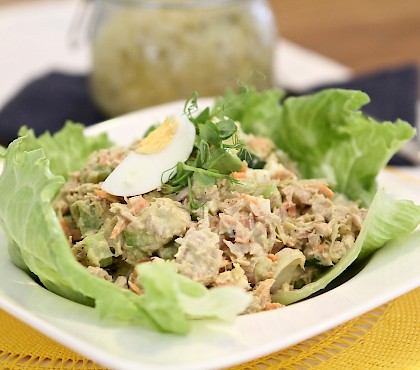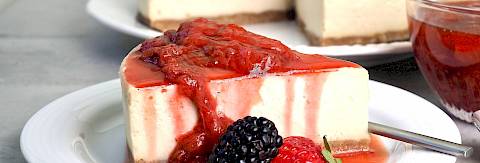
Carrot and Parsnip Muffins
- Serves: 12 muffins
- Prep Time: 00:15
- Cooking Time: 00:45
You will get a nice serve of vegetables in these muffins. The muffins have a lovely soft texture and are delicious served warm for a light lunch or with a bowl of soup. You might also like to add some diced cooked bacon, add the bacon at the end with the grated vegetables.
Ingredients
* Please click on the green icon next to the ingredients listed below for extra details and helpful information.
- 2 cups almond meal/flour
- 1/4 cup coconut flour
- 1/4 cup arrowroot flour
- 3 Tbsp nutritional yeast flakes, or 1/4 cup of parmesan cheese if tolerated
- 1 1/2 tsp paprika, or to taste
- 3/4 tsp baking soda (bicarb)
- 3/4 tsp sea salt
- 4 lge egg(s)
- 1/2 cup almond milk, or milk of choice
- 1/4 cup macadamia oil
- 1/3 cup fresh basil leaves, roughly chopped
- 2 spring onion(s), sliced (plus some green tops)
- 1 lge (210g) carrot(s), grated
- 1 lge (210g) parsnip(s), grated
Directions
Preheat oven to 170c (fan-forced). Place paper liners in a 12 hole muffin tin or use a silicon muffin tray.
Add the almond meal, coconut flour, arrowroot flour, nutritional yeast flakes, paprika, baking soda and salt to a food processor. Process for 15 seconds to combine and create a fine texture.
Add the eggs, milk and oil. Process for 10 - 12 seconds to combine all the ingredients.
Add the basil and sliced spring onions, pulse a few times to blend evenly through the mixture. Transfer the mixture to a large bowl and add the grated carrot and parsnip. Stir well to distribute the vegetables evenly through the mixture (if you are using bacon add at this time).
Spoon the mixture into the prepared muffin tin and smooth the tops. Bake for 45 - 50 minutes or until firm to the touch and golden. Let sit for 15 minutes before serving.
Serve warm or at room temperature with ghee or grass-fed butter. Suitable to freeze.
You may also like
almond meal/flour
The most favoured gluten/grain free flour substitute in my kitchen is almond meal. It is finely ground blanched almonds and is also known as almond flour. It has a slightly sweet flavour so you don’t have to add as much sweetener when baking with it. Almond meal/flour is rich in manganese which helps the body heal after injuries and also helps the body break down carbohydrates. Almond flour is also rich in magnesium, which can help control your blood sugar levels. It's rich in vitamin E and other antioxidants, which may help reduce the risk of serious health conditions like cancer, diabetes, stroke, and heart disease. Almonds are also a good source of calcium.
All kinds of nuts can be ground down to make a meal and are excellent for raw cheesecake or pie bases. Nut meals/flours are best stored in airtight containers in the fridge or freezer to prevent them going rancid.
coconut flour
Coconut flour is made by drying and grinding the meat of a coconut to a fine texture. Coconut flour is a low-carb flour that's an excellent source of dietary fibre and protein. It's a good grain-free and nut-free alternative but does require a larger amount of liquid than normal when used for baked goods. When replacing in a recipe that calls for wheat flour (or almond meal), use this guide; 1 cup of regular flour = 1/3 cup coconut flour, add an extra egg and an extra 1/3 cup of liquid. It can be used in soups, gravies and stews as a thickener and adds a boost of nutrition. Coconut flour may promote stable blood sugar levels and a healthy heart. In addition, it may have antibacterial properties and aid digestion and weight loss. There are now quite a few brands of coconut flour available and they all seem to perform differently depending on how coarse the texture is. In my recipes, I used Organic Coconut Flour from 'Let's Do Organic' and 'Red Tractor Foods' I like their finer texture.
arrowroot flour
Arrowroot is a herb, the roots are cultivated for its starch properties. It is used in my recipes as a thickener and I also like combining it with almond meal to produce a much lighter texture, more like a gluten flour. I find the starch helps to bind the ingredients together. You can substitute tapioca flour, which is made from the dried roots of the cassava plant. Tapioca can be used in baking, it has a slightly sweet flavour. However, I do not recommend thickening with tapioca, as it has a stretchy, gummy texture. Supermarkets only sell in very small containers, which is not cost effective. Purchase from baking specialty stores, health food stores or online. ( When substituting for cornflour in recipes, 2 teaspoons arrowroot = 1 tablespoon cornflour/starch).
nutritional yeast flakes
Also know as Savoury Yeast Flakes. It’s a fermented and deactivated yeast, which means it isn’t going to grow (and has nothing to do with brewer’s yeast or bakers’ yeast). It has a creamy cheesy flavour and I’ve used it in a few recipes to create a cheese flavour. Vegans use it as a condiment and a cheese substitute, and to also add additional protein and vitamins to their diet (it’s a complete protein). Nutritional yeast flakes are free from sugar, dairy, grains and gluten. Do not confuse it with yeast extract (MSG). Purchase from health food stores or in the health food aisle of supermarkets.
paprika
Paprika is a spice made from grinding dried mild and sweet red chili peppers. Paprika is used to add colour and flavour to a dish. It has a sweet pungent flavour and distinct bitter aftertaste. Even just a small sprinkle of paprika can deliver antioxidants and nutrients like, Vitamin A, E and B6, also iron. I purchase an organic paprika made by 'Simply Organic' (from iherb.com). Paprika is a nightshade.
baking soda (bicarb)
Also known as Bicarbonate of Soda or Sodium Bicarbonate and is used as a rising agent in baking, it contains no gluten or grains. I use Bob's Red Mill baking soda as I find it rises better than other brands I've tried.
sea salt
Organic unbleached, unrefined organic Celtic sea salt or pink Himalayan salt is my salt of choice as these contain healthy minerals and trace elements that our body needs. Regular table salt has been bleached, refined and processed leaving minimal health benefits. If you choose to use regular table salt in my recipes you will need to reduce the quantity or the end result will be to salty.
egg(s)
I have used large free range or organic eggs from a 700g carton in my recipes. Eggs are one of the few foods considered to be a complete protein because they contain all 9 essential amino acids, also studies have shown that lutein (yellow colour) in egg yolks protects against the progress of early heart disease.
almond milk
A dairy free milk made from soaking almonds over night, rinsing well and blending with fresh water. Drained through a nut bag and all the liquid milk squeezed out. Recipe on page 297 of The JOYful Table cookbook, if purchasing a commercial brand, read label to avoid added sugars, gums, thickeners and preservatives.
macadamia oil
Macadamia nut oil is the non-volatile oil expressed from the nut meat of the macadamia tree, a native Australian nut. I avoid heating to very high temperatures but use it extensively for grain free baking at lower temperatures in the oven. Delicious over salads and it's also one of the healthier nuts, as it's higher in Omega 3 oils than other nuts.
basil leaves
The culinary herb basil is of the mint family. The type used in Italian dishes is sweet basil opposed to Asian dishes which may use Thai basil, lemon or holy basil. I prefer to add at the end of a recipe or toss through as I serve a dish as cooking can destroy the flavour.
spring onion(s)
Other names for spring onion are scallion or green onion. They have hollow green leaves and a small root bulb and can be eaten raw or cooked. The green tops are also used sliced or chopped as a garnish. The green tops are a good source of vitamin C and beta carotene.
carrot(s)
This crunchy orange root vegetable is rich in beta-carotene, which is converted into vitamin A in the liver. They are good for the eyes and improve night vision. You get vitamin A and a host of other powerful health benefits from carrots, including cancer prevention, helps prevent infections and heart disease, protects teeth and gums and promotes healthier skin.
parsnip(s)
Parsnip is a root vegetable closely related to the carrot and grown as an annual. It has a sweet flavour, delicious in stews and soups, roasts well and I enjoy them cut into fries or chips and cooked in coconut oil. Parsnips are high in vitamins and minerals, especially potassium and also contain both soluble and insoluble dietary fibre. Choose firm parsnips with light coloured skin in season.


